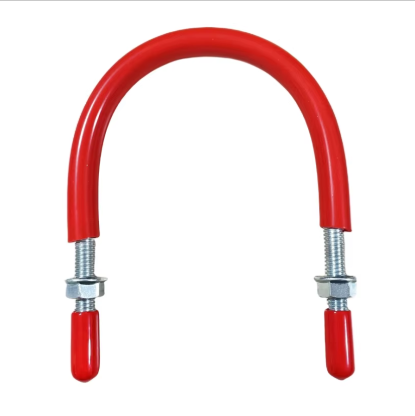Corrosion Resistance in Harsh Environments
Stainless steel U-bolts stand out because they resist rust and corrosion so well, which is why they're essential in places where there's lots of moisture and salt around, especially on boats and in factories near coastlines. Recent improvements in how these bolts are treated during manufacturing have boosted their ability to withstand harsh conditions even more, meaning they last longer before needing replacement and save money over time. What grade of stainless steel something is made from really matters when it comes to resisting corrosion. Take 316 stainless steel for example it handles salty environments much better than regular 304 stainless steel does. Studies show that parts made from 316 grade can actually last up to ten times longer than cheaper alternatives when exposed to the same conditions. That's why many engineers specify 316 stainless steel U-bolts for critical jobs in tough environments where things need to stay strong and reliable for years without failing.
Durability for Heavy-Duty Applications
Stainless steel U-bolts stand out because they last so long, which makes them perfect for tough jobs where things get really stressed out. Think construction sites or car manufacturing plants where equipment needs to hold up against all sorts of forces. Some of these bolts can actually handle weights measured in tons according to what engineers say about load capacities. What matters most is how well they perform when pressure builds up over time. The material doesn't break down easily even after years of constant strain. Recent advancements in how these bolts are made have improved their ability to resist wear and tear from repeated loading cycles. So instead of bending or breaking down after months of use, they keep doing their job reliably day after day. That's why so many builders and mechanics rely on them for critical connections throughout different kinds of structures.
Key Features to Consider in 2024
Material Grades: 304 vs. 316 Stainless Steel
Knowing the difference between 304 and 316 stainless steel matters a lot when picking out U-bolts. What we choose impacts both wallet size and how well these fasteners hold up over time in different conditions. Grade 304 steel works fine for most everyday jobs since it doesn't break the bank. But things get tricky in tougher settings. That's where 316 comes into play because it has molybdenum added during manufacturing, which gives better protection against rust and degradation. Many industries have started moving toward 316 lately, particularly those operating near saltwater areas or on ships. The extra durability means these bolts last longer before needing replacement, making them worth considering despite higher initial costs for projects exposed to harsh elements like sea air and brine.
Load Capacity and Thread Specifications
Getting the load capacity right matters a lot when picking out a U-bolt that can actually stand up to what it needs to hold. Look at both how heavy things are going to be and where exactly the bolt will end up working. The threads on these bolts matter too. Getting them right makes all the difference between something holding tight or coming loose under stress. Most technical manuals stress this point pretty hard because nobody wants their equipment failing unexpectedly. Safety comes first after all. When selecting between coarse and fine threads, think about what kind of job needs doing. Coarse threads work better in rough environments while fine ones offer greater precision for delicate installations.
Customization Options for Unique Needs
For many industries where projects call for special specs like unusual sizes, custom lengths or special coatings on U-bolts, customization just isn't optional anymore. The market seems to be moving toward more personalized solutions these days, so most manufacturers have started offering expanded customization choices. Construction firms, infrastructure projects and even some manufacturing plants need bolts that fit exactly what they're building. Talking shop with suppliers about what can be customized really makes a difference in how well those U-bolts work with whatever system they're going into. Getting the right fit from day one saves headaches down the road when dealing with specialty applications.
Top 10 Stainless Steel U-Bolts in 2024
Dale Fastener 304 SS Square U-Bolts
Dale Fastenerâs 304 SS Square U-Bolts feature a robust square design specifically tailored for construction applications. Made from 304 stainless steel, these U-bolts offer a balance of performance and corrosion resistance across varied environments, making them an excellent choice for projects requiring durability and reliability.
Heartland Precision Round Bend U-Bolts
Known for precision engineering, Heartland Precision's round bend U-bolts ensure a firm grip, making them ideal for cylindrical applications. Available in multiple sizes, these U-bolts meet various industry standards for reliability, providing dependable solutions for diverse needs.
316 Marine-Grade Saltwater U-Bolts
These U-bolts, crafted from 316 marine-grade stainless steel, are specifically designed for marine environments. Their exceptional performance in saltwater makes them ideal for boat fittings, offering strong resistance against pitting and crevice corrosion.
Wuxi Lingdao Heavy-Duty Industrial U-Bolts
Wuxi Lingdao's U-bolts are manufactured to maintain structural integrity under substantial loads, making them suitable for heavy-duty industrial applications. Their reliable performance has earned preference across various sectors that demand robust and durable components.
Pro-Coat⢠Galvanized U-Bolts
Pro-Coat⢠Galvanized U-Bolts feature a unique finish that enhances corrosion resistance, making them perfect for outdoor use. The galvanized coating offers robust protection against environmental factors, ensuring longevity and trust in diverse conditions.
347 High-Temperature U-Bolts
Specially engineered for high-temperature applications, 347 High-Temperature U-Bolts withstand extreme thermal conditions. They are ideally suited for industries such as oil and gas, where performance in challenging environments is essential.
310 Stainless Extreme Environment U-Bolts
Designed for extreme conditions, 310 stainless U-bolts provide superior oxidation resistance. These are particularly advantageous in high-temperature exhaust systems, offering durability and performance where resilience is crucial.
Long Tangent Structural U-Bolts
Long Tangent Structural U-Bolts are uniquely designed with a long tangent that provides enhanced grip and stability in structural applications. These U-bolts excel in railway and road construction projects, where reliable connection and support are necessary.
Anchor U-Bolts for Secure Installations
Anchor U-Bolts play a crucial role in ensuring secure installations across varied applications. They enhance overall structural integrity by offering a reliable connection, making them indispensable in building and construction industries.
Custom M6-M24 Threaded U-Bolts
Custom M6-M24 Threaded U-Bolts provide flexibility in design and assembly needs by offering threading from M6 to M24. These customizable U-bolts cater to specific fastening requirements, allowing for tailored solutions in specialized applications.
Applications Across Industries
Marine and Offshore Rigging
Marine rigging just wouldn't work without stainless steel U-bolts because they resist corrosion so well and hold up under pressure. These bolts support everything from docks to boat rigging where regular hardware would fail after months in saltwater. Saltwater is brutal on metal components, but stainless steel stands up to it year after year. Boaters know this when they secure their anchors or fasten cables along yacht hulls. The bolts keep performing even when exposed to constant moisture and ocean spray. Most shipyards have made the switch to stainless steel for exactly these reasons. Boat owners appreciate not having to replace hardware every season, which saves money and keeps vessels safer during rough weather conditions.
Industrial Pipe and Machinery Fastening
U-bolts play a vital role in holding pipes and machinery together across industrial environments. They handle heavy weights and stand up to constant vibrations without failing. The market for stainless steel U-bolts has been growing steadily in recent years, showing how manufacturers are moving toward stronger, longer lasting fasteners. Factories and construction sites need reliable connections that won't break down over time. Stainless steel offers excellent resistance to rust and corrosion, which means mechanical systems last longer between repairs. Maintenance crews spend less time fixing bolt failures, and operations run smoother overall. For anyone working with industrial piping or heavy equipment, switching to stainless steel U-bolts makes sense both from a safety standpoint and for cutting long term replacement costs.
Architectural and Construction Supports
Stainless steel U-bolts are essential parts of many construction jobs because they're strong enough to hold things together and can withstand harsh conditions outside. Contractors use them all over the place really. Think about how buildings get assembled, or those big signs we see on highways, even decorative features in public spaces rely on these bolts. What makes them so popular? Well, besides being tough, they look good too which matters when aesthetics count. For projects that face rain, snow, or sun exposure day after day, these bolts keep everything secure without corroding away. That's why we keep seeing more stainless steel U-bolts showing up at construction sites lately. They help ensure buildings stand up straight and stay put no matter what Mother Nature throws at them, which explains why architects specify them so often nowadays.
Maintenance Tips for Longevity
Preventing Galvanic Corrosion
Stainless steel U-bolts last longer if we stop galvanic corrosion before it starts. This happens when dissimilar metals touch each other and start swapping electrons. Compatibility matters a lot between our stainless steel bolts and whatever else they're attached to in an assembly. Protective coatings make all the difference too. So does getting the installation right from day one. These coatings act as barriers against moisture and chemicals while good installation practices keep things aligned properly. Without them, even small amounts of corrosion can lead to premature failure down the road. Most mechanics know this stuff by heart after seeing what happens when shortcuts are taken with metal fasteners.
Regular Inspection Best Practices
Checking stainless steel U-bolts regularly keeps them reliable in the long run. Look out for rust spots, bent shapes, or fittings that feel loose when touched. These checks catch problems before they get serious, stopping failures down the road. When doing these inspections, follow good methods so any issues with how solid the bolts actually are get fixed fast. This not only makes the bolts last longer but also keeps whatever structure they're holding up safe from damage. A few minutes spent looking at those bolts now saves headaches later on.
When to Replace Worn U-Bolts
Figuring out when those old U-bolts need replacing matters a lot for keeping things safe and running properly. Keep an eye on how they perform during routine checks so we spot problems early before they get serious. When wear starts showing up, getting them replaced right away stops sudden breakdowns from happening. This keeps everything stable and working well while avoiding dangerous situations down the road. Plus, it helps maintain good operation without unnecessary downtime or repairs later on.
FAQ
What makes stainless steel U-bolts essential in 2024?
Stainless steel U-bolts are essential due to their superior corrosion resistance, durability, and adaptability to harsh environments, making them ideal for both marine and industrial applications in 2024.
What is the difference between 304 and 316 stainless steel?
304 stainless steel is cost-effective for general use, while 316 stainless steel, with added molybdenum, offers enhanced corrosion resistance for harsher environments.
How do stainless steel U-bolts contribute to safety in industrial applications?
They offer exceptional durability and resistance to tensile and shear stresses, ensuring safety in high-load and repetitive stress conditions.
In which industries are stainless steel U-bolts commonly used?
Their applications range across marine, industrial, and construction sectors, providing essential support and fastening solutions.
Table of Contents
- Corrosion Resistance in Harsh Environments
- Durability for Heavy-Duty Applications
- Key Features to Consider in 2024
-
Top 10 Stainless Steel U-Bolts in 2024
- Dale Fastener 304 SS Square U-Bolts
- Heartland Precision Round Bend U-Bolts
- 316 Marine-Grade Saltwater U-Bolts
- Wuxi Lingdao Heavy-Duty Industrial U-Bolts
- Pro-Coatâ„¢ Galvanized U-Bolts
- 347 High-Temperature U-Bolts
- 310 Stainless Extreme Environment U-Bolts
- Long Tangent Structural U-Bolts
- Anchor U-Bolts for Secure Installations
- Custom M6-M24 Threaded U-Bolts
- Applications Across Industries
- Maintenance Tips for Longevity
- FAQ

